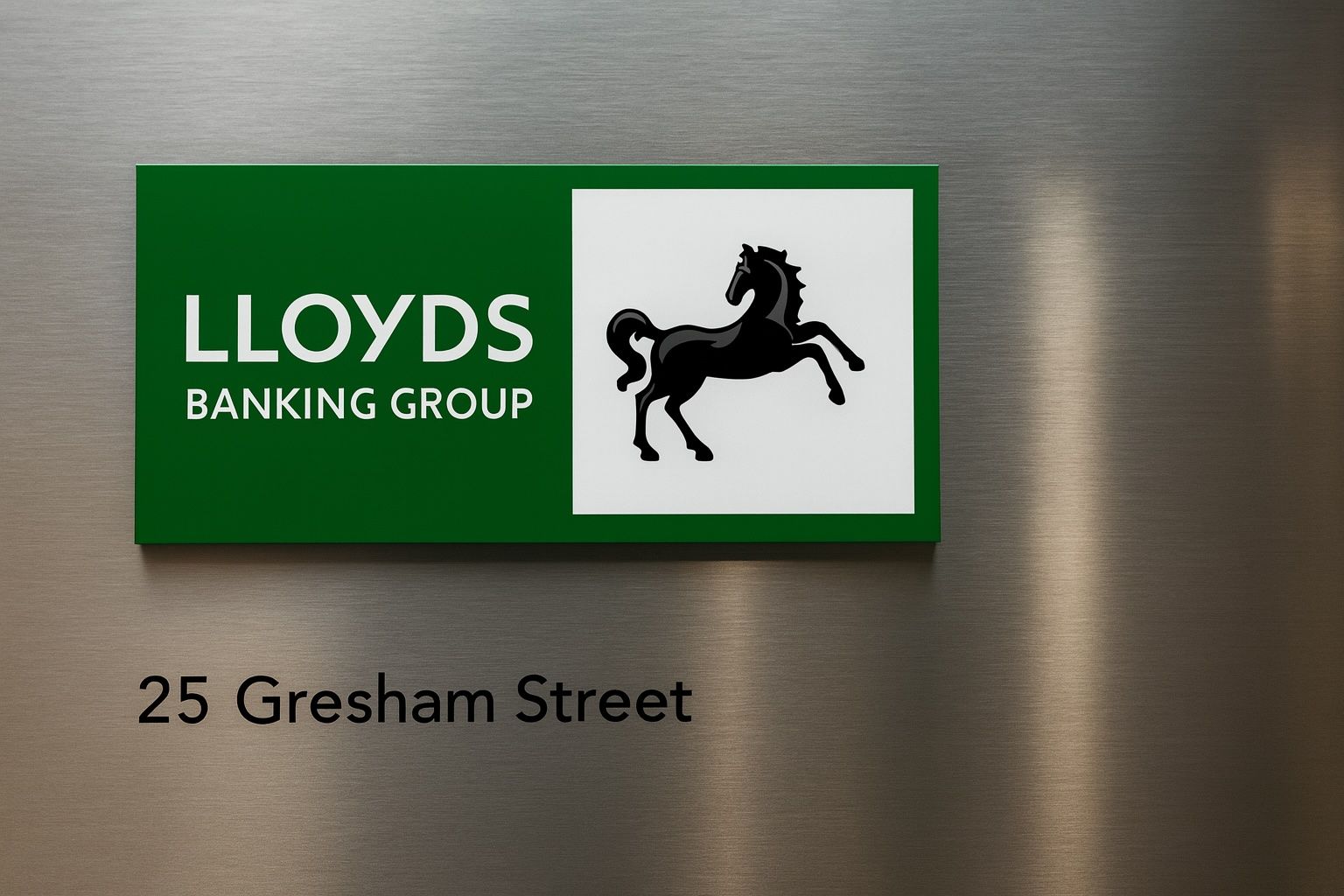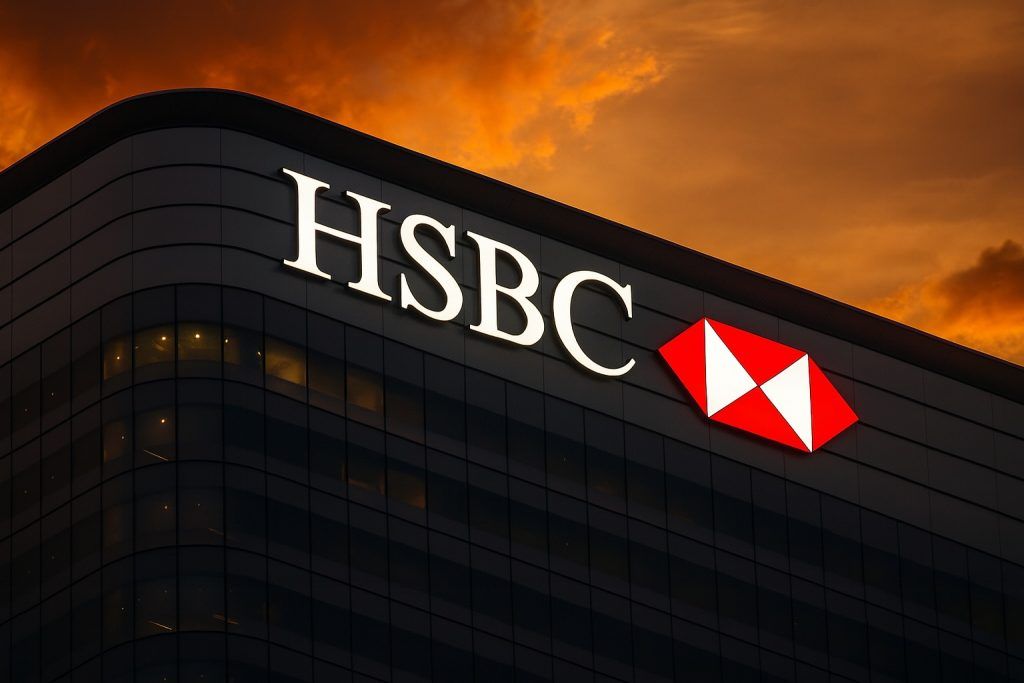Lloyds Banking Group’s share price eased back on Friday, 21 November 2025, as investors digested a fresh block listing of 195 million shares and continued to weigh the bank’s big push into digital wallets via the Curve acquisition.
Lloyds share price today (LON: LLOY)
As of the close on 21 November 2025, Lloyds Banking Group plc (LON: LLOY) shares were trading at around 86.7–86.9p, down roughly 0.8–0.9% on the day from Thursday’s 87.42p finish. [1]
Key trading stats for today:
- Last price (approx.): 86.7–86.9p
- Day change: about -0.7p to -0.8p (around -0.8% vs previous close) [2]
- Day’s range:85.82p – 86.98p [3]
- Previous close (20 Nov): 87.42p [4]
- 52‑week range: roughly 52.44p – 95.86p [5]
- Market capitalisation: about £51bn at today’s closing level [6]
Despite today’s modest pull-back, Lloyds remains one of the FTSE 100’s standout performers in 2025:
- 1‑week performance: about +7%
- 1‑month performance: around +5%
- 1‑year performance: up roughly 58%
- 5‑year performance: total return of about 144% (share price only, before dividends) [7]
That strong multi‑year rally is exactly what prompted one new article today to note that £10,000 invested in Lloyds five years ago would now be worth around £24,600, highlighting how much of that upside has arrived in the last two years. [8]
All the key Lloyds news dated 21 November 2025
Several fresh developments connected to Lloyds hit the wires today (21 November), directly or indirectly influencing sentiment around the stock.
1. Block listing of 195 million shares for employee plans
Lloyds confirmed via a regulatory announcement that it has applied for a block listing of 195,000,000 ordinary shares of 10p each. [9]
According to the filing:
- The shares support long‑term incentive and employee share ownership schemes, including:
- Executive Group Ownership Plan 2016
- Long Term Share Plan 2020
- Share Incentive Plan
- Sharesave Scheme 2017 [10]
- Admission to trading on the London Stock Exchange is expected on 24 November 2025. [11]
Because this is a block listing for schemes, not a traditional capital raise, the shares are issued over time as employees exercise options or receive awards. The press release stresses that the new stock will rank pari passu with existing ordinary shares – meaning identical rights on dividends and voting. [12]
For existing shareholders, the main implications are:
- Mild, gradual dilution as shares are issued under the plans, partly offset by the bank’s ongoing share buyback programme of up to £1.7bn, announced earlier this year. [13]
- A signal that Lloyds remains committed to equity‑linked pay for staff and senior management, aligning incentives with long‑term share price performance.
Markets typically treat these routine block listings as neutral to slightly negative in the very short term (because they add to potential share supply) but they are standard practice for large UK banks.
2. Creative Planning boosts Lloyds ADR holding
In the United States, Creative Planning, a large wealth and asset management firm, disclosed that it increased its position in Lloyds’ New York–listed ADR (ticker: LYG).
In a new 13F filing covered today by MarketBeat, Creative Planning reported: [14]
- A 15.1% increase in its Lloyds stake during Q2
- It now holds about 1.37 million ADRs, valued at roughly $5.8m at the time of filing
- Several other US wealth managers also modestly raised holdings, although overall institutional ownership of Lloyds in the US remains modest (a little over 2% of the company’s stock according to that report).
While this is historical (Q2) data, the article landing today underscores ongoing international interest in Lloyds following its strong 2024–2025 recovery and rising dividend stream.
3. Rating agency action from Japan (R&I)
A short note published today by Rating and Investment Information, Inc. (R&I) in Japan confirms that the agency has taken a rating action on Lloyds Banking Group plc. The summary indicates the rating was “affirmed”, and R&I also commented on the outlook, although the full details of the rating level and outlook wording are behind a paywalled PDF. [15]
For investors, the key takeaway is that at least one international rating agency is keeping Lloyds at its existing rating level, which supports the picture of a solid, if not risk‑free, credit profile despite ongoing motor finance provisions and UK macro uncertainty.
4. New analysis highlighting past returns and valuation
Two pieces of fresh or very recent commentary frame how the market is thinking about Lloyds after its strong run:
- Motley Fool UK: Today’s feature emphasises that Lloyds’ share price has more than doubled in five years and that much of the gain has come in the last 24 months, then debates what could come next. [16]
- Morningstar: A note published yesterday lists Lloyds among a group of “newly overvalued” stocks, arguing that the rally has pushed its valuation above their estimate of fair value. [17]
Together they highlight a growing split in opinion: some see Lloyds as a still‑attractive play on UK banking and higher rates, while others think the easy money has already been made.
How today’s move fits into Lloyds’ 2025 rally
Even after today’s dip, Lloyds is still having an exceptional year:
- The share price is up nearly 60% over the last 12 months, with gains in the double‑digits over 6 and 12‑month periods. [18]
- The stock sits just below 10% off its 52‑week high around 96p, reached earlier in November. [19]
Several factors lie behind this recovery:
- Improved profitability and higher rates: Lloyds has been one of the clearest beneficiaries of higher UK interest rates, which have widened net interest margins over the last couple of years.
- Capital returns: The bank is in the middle of a £1.7bn share buyback, alongside a rising dividend (current yield about 3.7%). [20]
- Digital and AI strategy: A series of announcements this month – including an AI‑powered financial assistant and a dedicated digital & AI strategy update – has reinforced Lloyds’ push to be seen as a tech‑forward retail bank, not just a legacy lender. [21]
At the same time, the share price has been volatile due to regulatory and macro risks:
- Lloyds has already taken around £1.95bn in provisions related to the UK motor finance mis‑selling scandal, including an extra £800m charge announced in October. [22]
- In its third‑quarter update, the bank reported a 36% drop in Q3 profit and cut its guidance for the full year, largely because of those motor finance costs. [23]
Today’s relatively small decline looks more like consolidation after a big rally than a major change in the story.
Curve acquisition: still a major backdrop for the share price
Although the acquisition was announced on 19 November, the market is still digesting what Lloyds’ move for Curve means – and it remains a key part of the backdrop to today’s trading.
What we know so far:
- Lloyds is acquiring Curve, a London‑based fintech whose app combines multiple bank cards into a single digital wallet, with rewards and “go back in time” features that let users shift past transactions between accounts. [24]
- Multiple reports put the deal value at around £120m, subject to regulatory approval. [25]
- The transaction is expected to complete in the first half of 2026, with Curve’s technology being integrated into Lloyds’ mobile platform. [26]
- Lloyds has said the acquisition is aimed at accelerating its digital transformation, not at delivering a near‑term profits boost, and does not expect a material impact on 2025–26 financial results. [27]
For the share price, Curve has two competing effects:
- Strategic upside – It strengthens Lloyds’ digital wallet offering and could help retain younger, more mobile‑first customers, which supports long‑term growth and cross‑selling.
- Execution and cost risk – Integrating a fast‑moving fintech into a large, regulated bank is never trivial, and a few commentators have already questioned whether the price is attractive enough given Curve’s past fundraising history. [28]
So far, markets seem to view the deal as strategically sensible but not transformational, with more attention still focused on capital returns and regulation.
Capital returns vs new shares: buybacks and the block listing
One theme investors watched closely today is the tension between share buybacks and new share issuance:
- On one side, Lloyds is buying back billions of pounds of stock, shrinking the share count and boosting earnings per share. [29]
- On the other, the bank has just applied for a block listing of 195m new shares for employee plans. [30]
Putting that in context:
- Lloyds has about 58.9 billion shares in issue, so 195m shares equate to roughly 0.3% of the share capital. [31]
- The buyback is far larger than the potential new shares, so the overall direction of travel is still towards a smaller share count over time.
In other words, today’s block listing is not a fundamental shift in the capital story, but it’s a detail that short‑term traders may factor into supply‑and‑demand calculations.
Valuation and analyst views after today’s move
Even after the pull‑back, Lloyds no longer looks like the “bargain‑basement” value play it was in 2022–2023.
Some key valuation markers:
- P/E ratio: about 13.9x the latest full‑year earnings. [32]
- Dividend yield: approximately 3.7%, based on recent payouts and today’s share price. [33]
Analysts remain broadly constructive:
- An aggregate of broker forecasts compiled by Investing.com shows an average 12‑month price target around 94p, with a high of 110p and a low of 53p. [34]
- That implies around 8–9% upside from today’s level, before dividends, and the consensus stance is effectively “Buy”, with no analysts in that sample rating the stock a “Sell”. [35]
However:
- Morningstar’s “newly overvalued” list suggests Lloyds may already be trading above their estimate of fair value, highlighting valuation risk if earnings disappoint. [36]
This mix of bullish broker targets and more cautious fair‑value models is one reason why the share price is now more sensitive to newsflow, such as today’s block listing and any fresh commentary ahead of the UK Autumn Budget on 26 November.
What could move the Lloyds share price next?
Looking beyond today’s session, several catalysts could swing Lloyds’ share price in the coming days and weeks:
- UK Autumn Budget (26 November 2025)
- Earlier this month, reports suggested UK banks may escape a harsher tax raid than feared, which boosted the sector. [37]
- Any surprise changes to bank levies, windfall taxes or capital rules in the final Budget could quickly re‑price Lloyds.
- Further updates on the motor finance scandal
- The FCA’s proposed redress scheme remains under consultation, and Lloyds has already warned that additional provisions “may be required” beyond the £1.95bn booked so far. [38]
- A tougher‑than‑expected final scheme would likely weigh on bank valuations.
- Integration news around Curve
- Investors will watch for details on product launches, customer migration and the cost of integration once regulatory approvals progress. [39]
- Interest‑rate expectations and UK macro data
- Lloyds is one of the UK banks most closely tied to the domestic economy; any shift in Bank of England policy expectations or weak UK data could move the shares disproportionately. [40]
Bottom line
On 21 November 2025, Lloyds Banking Group’s share price has eased back to the high‑80s pence after a strong run, in a session dominated by:
- Confirmation of a 195m‑share block listing for employee schemes
- Fresh visibility on international investors adding to positions in the ADR
- Ongoing debate over whether the stock is now fairly valued or over‑extended after a near‑60% 12‑month rally
For now, the consensus view still leans bullish, with analysts expecting moderate further upside and a solid dividend stream – but the margin for error is slimmer than it was a year ago, and newsflow around regulation, the Budget and the Curve deal is likely to keep LLOY on traders’ radar.
Disclaimer: This article is for information and news purposes only and does not constitute investment advice or a recommendation to buy or sell any security. Always do your own research or consult a regulated financial adviser before making investment decisions.
References
1. www.lse.co.uk, 2. www.lse.co.uk, 3. www.lse.co.uk, 4. www.lse.co.uk, 5. www.investing.com, 6. www.hl.co.uk, 7. www.hl.co.uk, 8. www.fool.co.uk, 9. www.investegate.co.uk, 10. www.investegate.co.uk, 11. www.investing.com, 12. www.investegate.co.uk, 13. www.investegate.co.uk, 14. www.marketbeat.com, 15. www.r-i.co.jp, 16. www.fool.co.uk, 17. global.morningstar.com, 18. www.hl.co.uk, 19. www.investing.com, 20. www.investegate.co.uk, 21. www.lloydsbankinggroup.com, 22. www.reuters.com, 23. www.reuters.com, 24. fxnewsgroup.com, 25. businesscloud.co.uk, 26. www.pymnts.com, 27. fxnewsgroup.com, 28. businesscloud.co.uk, 29. www.investegate.co.uk, 30. www.investegate.co.uk, 31. www.lse.co.uk, 32. www.hl.co.uk, 33. www.hl.co.uk, 34. www.investing.com, 35. www.investing.com, 36. global.morningstar.com, 37. www.reuters.com, 38. www.reuters.com, 39. fxnewsgroup.com, 40. www.investorschronicle.co.uk







